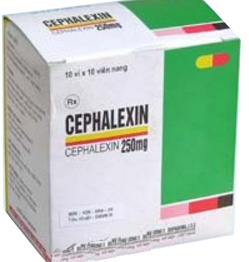Overview and Classification
Cephalexin, also known by its brand name Keflex, is a cephalosporin antibiotic. It belongs to the first generation of cephalosporins, which are effective against a broad spectrum of gram-positive bacteria and some gram-negative bacteria. It is primarily used to treat infections caused by these microorganisms, making it a versatile option in antibacterial therapy.
Mechanism of Action
Cephalexin works by inhibiting bacterial cell wall synthesis. It binds to penicillin-binding proteins within the bacterial cell wall, which interferes with the final step of peptidoglycan synthesis, leading to cell lysis and death. This bactericidal action effectively eliminates susceptible bacterial strains.
Indications for Use
Cephalexin is prescribed for the treatment of a variety of bacterial infections. These include respiratory tract infections like pneumonia, skin and soft tissue infections, otitis media, urinary tract infections, and bone infections. Its use is based on the assumption that the causative organism is susceptible to cephalexin.
Administration and Dosage
Cephalexin is available in oral formulations, including capsules, tablets, and suspension. Dosage is typically determined based on the infection type, severity, and patient-specific factors such as age and renal function. Common dosages range from 250 mg to 1 g, administered every 6 to 12 hours. The optimal dosage ensures maximum efficacy while minimizing the risk of adverse reactions.
Metabolism and Excretion
Cephalexin is predominantly absorbed from the gastrointestinal tract after oral administration. It is not extensively metabolized and is primarily excreted unchanged in the urine via renal excretion. The rate of elimination is influenced by the kidney’s functioning and is hence carefully monitored in patients with renal impairment.
Drug Interactions
Cephalexin can interact with other medications, potentially altering their effects. Probenecid can increase the plasma concentration of cephalexin by decreasing renal excretion. Concurrent use with anticoagulants like warfarin may potentiate the risk of bleeding. It is crucial to assess the patient’s medication profile to prevent adverse interactions.
Pediatric and Geriatric Use
Cephalexin can be used in pediatric patients, with dosage adjustments made based on the child’s weight and the severity of the infection. In geriatric patients, careful monitoring is necessary due to potential age-related renal function decline, which affects drug clearance. Dosage modifications may be required in these populations to ensure safe and effective treatment.
Pregnancy and Lactation
Cephalexin is classified under pregnancy category B, indicating no proven risk in humans. It should be used during pregnancy only if clearly needed. It is excreted in breast milk in trace amounts; thus, caution is advised when administering to nursing mothers. Risk and benefit should be assessed before prescribing to these populations.
Side Effects and Adverse Reactions
Common side effects of cephalexin include gastrointestinal disturbances such as diarrhea, nausea, and vomiting. Allergic reactions like rash, urticaria, and anaphylaxis are less common but possible. Hematological abnormalities such as eosinophilia and transient neutropenia may occur. Monitoring for liver function and renal function is advisable during prolonged therapy.
Resistance and Considerations
Bacterial resistance to cephalexin can develop, primarily through the production of beta-lactamases that hydrolyze the antibiotic. Resistance profiles should be considered when prescribing cephalexin, and susceptibility testing may be warranted to guide therapy. Prescribers aim to limit the use of antibiotics to situations where they are necessary to reduce the risk of resistance development.
Storage and Stability
Cephalexin should be stored at room temperature, protected from light and moisture. The reconstituted oral suspension must be refrigerated and is typically stable for 14 days. Proper storage conditions ensure the medication retains its efficacy and avoids degradation over time.
Formulary and Cost Considerations
Cephalexin is a cost-effective antibiotic available in generic forms, making it a preferred choice in formularies. Cost considerations are important in ensuring patient access and adherence, particularly in settings with financial constraints. It is a reliable option for empiric therapy where the infective organism is likely to be susceptible.








Reviews
There are no reviews yet.